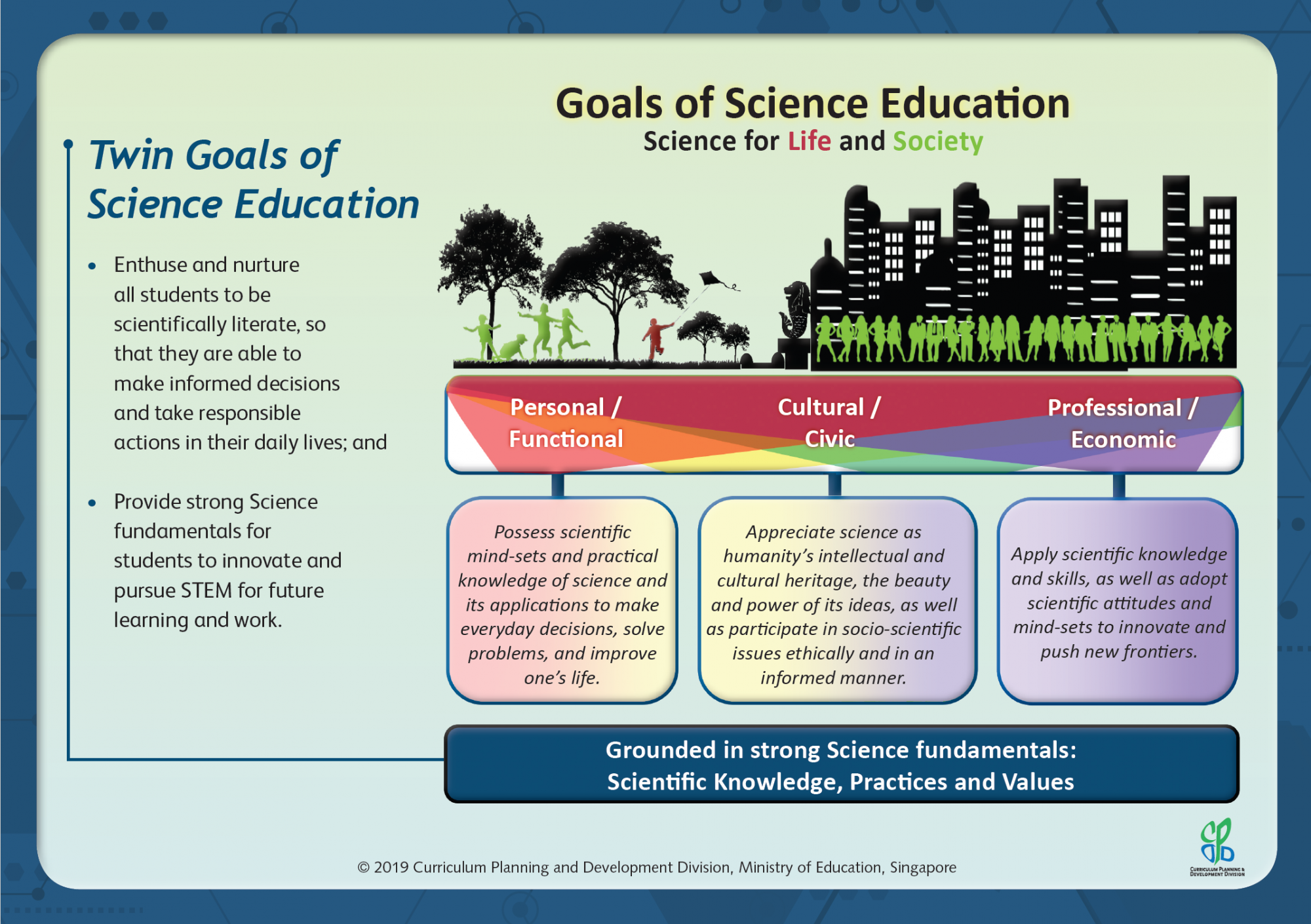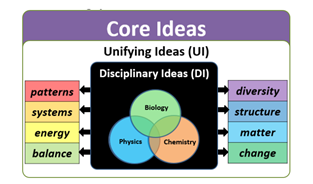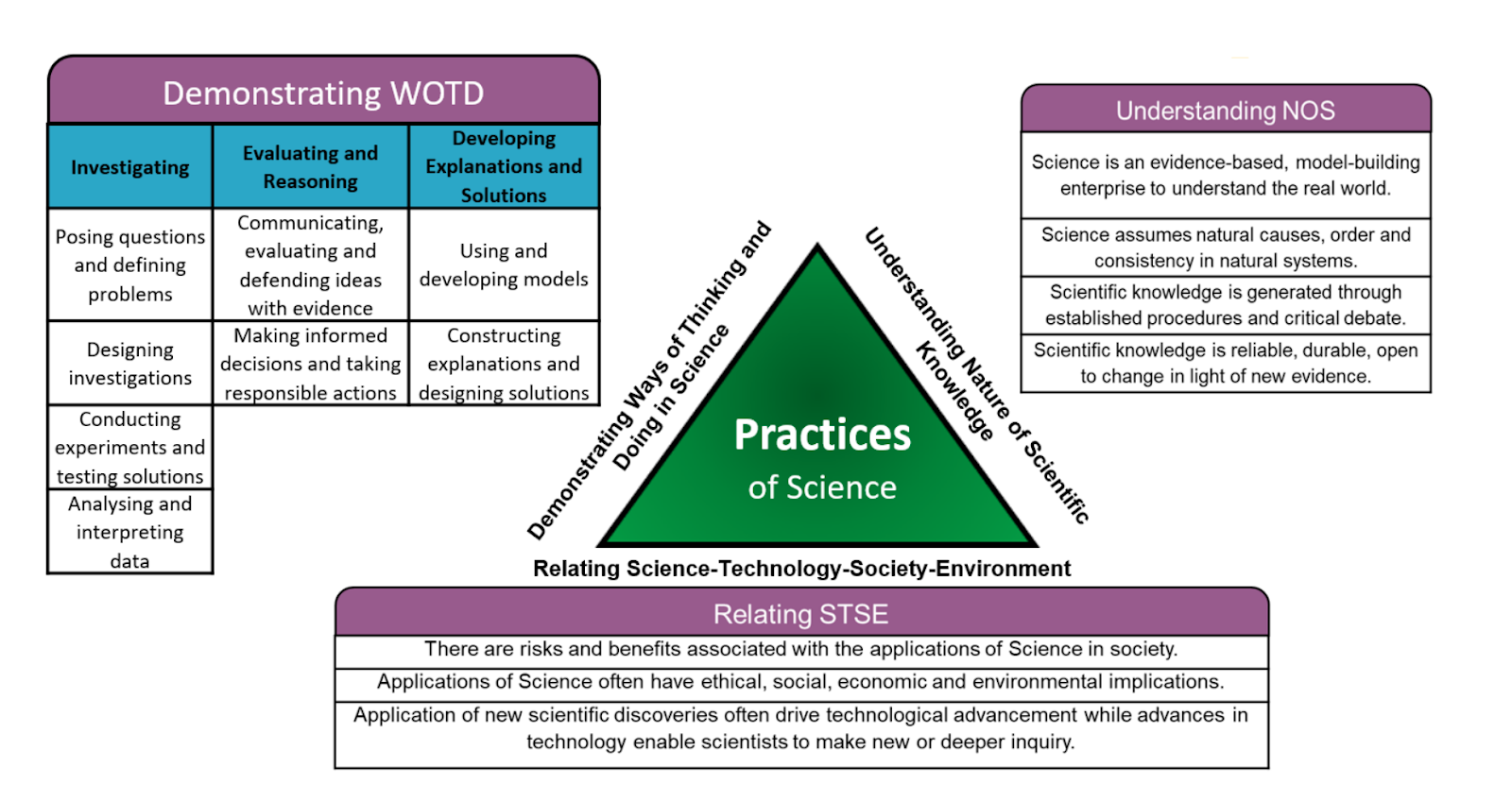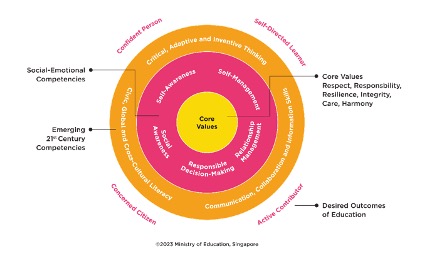https://drive.google.com/drive/u/1/folders/1cU2MPmAqcL_3GlJbqpF-jKqtjbd3hmSy
https://www.opal2.moe.edu.sg/app/learner/detail/course/9614c34d-db62-4ea1-a605-8bbf5d5e52b0
 |
| **Figure 1: Science Curriculum Framework** taken from https://www.corporationpri.moe.edu.sg/departments/science/ |
Our Science students are a varied group, each with unique needs, interests, and capabilities in Science. In light of this diversity and the specific requirements of Singapore, we have established two primary objectives for Science education:
 |
| Goals of Science Education https://www.jurongwestsec.moe.edu.sg/images/framework2.png |
- **Scientific Literacy for All:** We aim to inspire and cultivate a strong sense of scientific literacy among all students, enabling them to make well-informed decisions and act responsibly in everyday situations.
- **Strong Foundation for STEM:** We are committed to providing a robust foundation in Science for students, equipping them to innovate and excel in STEM fields for their future educational and career pursuits.
At the heart of our framework are the "Three I's" — Inspire, Inquire, and Innovate — which together articulate the vision of Science education. These core principles shape the desired experiences of our students in Science education:
- **Inspired by Science:** Students find joy and fascination in learning about science. They see the scientific connections in everyday phenomena and understand how science addresses global challenges. They see science as relevant and impactful, recognizing how scientific advancements and technology have revolutionized our world and enhanced our lives. This inspiration fosters openness to exploring science-related careers that contribute positively to society.
- **Inquire like Scientists:** Equipped with a solid foundation in science, students embody the spirit of scientific inquiry. They confidently engage in scientific practices, applying their knowledge to real-life, societal, and environmental issues. They critically assess and evaluate claims and ideas through logical, evidence-based scientific reasoning, yet remain cautious in the absence of evidence.
- **Innovate with Science:** Students use their scientific knowledge to develop innovative solutions to real-world challenges, from everyday problems to complex global issues. The aim is to cultivate a generation ready to contribute to STEM fields through research, innovation, and enterprise, driving forward scientific and technological progress.
The outer ring of our framework illustrates the domains essential for establishing strong science fundamentals: Core Ideas of Science, Practices of Science, and Values, Ethics, and Attitudes in Science.
- **Core Ideas (CI) of Science**:
 |
| Core Ideas https://www.riversidepri.moe.edu.sg/images/Science3.png |
- Pattern A pattern is an observed sequence or repetition in nature. A way to make sense of the world around us is to organise its diversity through classification based on similarities and differences, and recognising deviations. Understanding patterns helps us to predict events and processes that occur in the natural world.
- Diversity Diversity refers to the variety of living and non-living things around us. Such diversity in the natural and man-made worlds helps to maintain a balance in the ecosystem and provides us with useful resources to develop solutions to real-world problems. We have to use the resources in nature responsibly and sustainably.
- System A system comprises parts which interact with one another within a boundary. Interactions within and between systems can be explored at different scales. Studying systems allows us to understand how different parts with different functions, may work together for a common purpose.
- Structure Structure refers to the arrangement of and relations between parts of a system. Making sense of the structure of systems and their parts leads to a deeper understanding of their functions and properties, which allows us to make and test predictions of their behaviours.
- Energy Energy is required for things to work. The total amount of energy within a chosen system is always the same (i.e., conserved). While energy cannot be created or destroyed, it can be transferred from one energy store to another during an event or process. In these processes, some energy may become less useful.
- Matter Matter is anything that has mass and occupies space. Matter in the Universe, living and non-living, is made up of very small particles called atoms. The behaviour and arrangement of the atoms explain the properties of different materials. We can better appreciate nature by understanding the structure and properties of matter.
- Balance Balance is achieved when opposing forces or influences act on a system to allow the system to be in equilibrium or in a steady state. Maintaining balance is important in living things and in ecosystems. We are able to design stable systems by understanding the mechanisms by which balance is achieved.
- Change Change is caused by interactions within and across systems, which may involve forces or the flow of matter and energy.
The curriculum is organized around Core Ideas, which are central to understanding science. These ideas create coherence and conceptual connections across different scientific disciplines, such as biology, chemistry, and physics. They also provide a structure to visibly trace students' progression in their scientific understanding at various educational levels. This organization enables teachers to tailor lessons to the developmental stage of students, facilitating a gradual deepening of scientific comprehension.
- **Practices of Science (POS)**: Comprising three key components:
 |
| POS taken from https://www.riversidepri.moe.edu.sg/images/Science2.png |
1. **Demonstrating Ways of Thinking and Doing in Science (WOTD)**: This involves the active engagement in scientific methods and thought processes.
- W1. Posing Questions and Defining Problems: Scientific inquiry begins with posing questions about both natural and human-made worlds, focusing on their nature and mechanics. The practical applications of science are often driven by the need to solve specific problems, involving the formulation of questions that can be addressed through scientific and technological means.
- W2. Designing Investigations: Scientific investigations form a core part of exploring phenomena, testing theories, or evaluating models that describe the world. In practical applications, investigations aim to find the best solutions or enhance technological systems. Planning such investigations involves considering various factors like fairness, the required equipment, and the type of data (qualitative or quantitative) necessary.
- W3. Conducting Experiments and Testing Solutions: This practice entails applying specific techniques and methods using a variety of apparatus and equipment, aiming to test theories or improve technological applications.
- W4. Analyzing and Interpreting Data: Scientists organize and interpret data to uncover patterns and relationships, which serve as evidence for further communication. Engineers use these insights to assess and predict the effectiveness of models or prototypes.
- W5. Communicating, Evaluating, and Defending Ideas with Evidence: Scientific and technological practices require the clear and convincing communication of ideas across different formats (oral, written, visual) and media (journals, newspapers, online). This process includes rigorous reasoning, argumentation, and critique based on evidence, ensuring that explanations and solutions gain acceptance within their respective communities.
- W6. Making Informed Decisions and Taking Responsible Actions: This involves skillfully identifying and analyzing situations, reflecting on the implications of decisions considering various factors such as economic, social, environmental, and ethical dimensions.
- W7. Using and Developing Models: Models act as approximations of real-world phenomena or systems based on evidence, used to describe, explain, and predict outcomes. They are essential for advancing scientific inquiry and analyzing technological systems and are subject to revision based on new evidence.
- W8. Constructing Explanations and Designing Solutions: Science aims to elucidate the causes behind phenomena, while its applications focus on solving real-world problems. This process is iterative and systematic, involving the construction of explanations and the design of effective solutions.
2. **Understanding the Nature of Scientific Knowledge (NOS)**: This pertains to recognizing how scientific knowledge is formed and validated.
- N1. Science as an Evidence-Based Endeavor: Science seeks to understand the natural world through evidence-based and model-building approaches. It uniquely relies on empirical standards, logical reasoning, and critical reviews, encompassing both the accumulated knowledge about natural systems and the methodologies to refine and expand this knowledge.
- N2. Foundational Assumptions of Science: Science operates under the assumption that natural phenomena have underlying causes and that these phenomena occur in orderly and consistent patterns that can be understood through observation and measurement. Scientists formulate hypotheses, develop theories, and construct models to explain these patterns. Scientific laws describe consistent observations of natural phenomena, while theories provide well-substantiated explanations, continually verified through empirical evidence.
- N3. The Social and Collaborative Nature of Science: Scientific knowledge is produced through established methods and critical discussions within the scientific community. This collaborative and social aspect of science is mirrored in science education, where students engage in presenting their findings and ideas, fostering creativity and communal learning. Creativity in science manifests as students propose new ways to observe, measure, infer, and explain data.
- N4. The Dynamic Nature of Scientific Knowledge: Scientific knowledge is both reliable and subject to modification in response to new evidence or better arguments. Explanations within science are provisional and revisable, reflecting its progressive nature. Scientific understanding evolves as new explanations supplant outdated ones, highlighting the adaptability and forward-moving trajectory of science.
3. **Relating Science, Technology, Society, and Environment (STSE)**: This highlights the application of science in various societal contexts.
- R1. There are risks and benefits associated with the applications of science in society. Science and its applications have the potential to bring about both benefits and harm to society.
- R2. Applications of science often have ethical, social, economic, and environmental implications.
- R3. Applications of new scientific discoveries often inspire technological advancements while advances in technology motivate scientists to ask new questions and/ or empower scientists in their inquiry (e.g., collecting more precise data or carrying out more complex data analysis).
These practices underscore that science is not just about acquiring facts and theories but also involves a specific way of thinking and interacting with the world. Observations and experiments lead to scientific knowledge, which is both influenced by and influences societal beliefs and practices. This interconnectedness shows how scientific methods contribute to the development of theories that explain and predict natural phenomena.
- **Values, Ethics, and Attitudes (VEA) in Science**:
 |
| image taken from https://www.chijstjosephsconvent.moe.edu.sg/images/Curriculum/Science/S2.png |
- Curiosity
- Creativity
- Open-mindedness
- Resilience
- Integrity
- Responsibility
- Objectivity
- Healthy scepticism
- Curiosity: A desire to explore and understand the world around us.
- Creativity: The ability to think outside the box and develop new ideas.
- Open-mindedness: Willingness to consider different ideas and perspectives.
- Resilience: The capacity to recover quickly from difficulties and adapt to challenges.
- Integrity: Adherence to strong moral and ethical principles.
- Responsibility: The ability to take ownership of one’s actions and their consequences.
- Objectivity: Evaluating situations and information without bias.
- Healthy Skepticism: Questioning ideas and assertions in a thoughtful and constructive manner.
Science is an objective discipline that operates within diverse social contexts and is inherently human-centric. The curriculum aims to foster an understanding of the ethical dimensions of scientific work. This involves sensitizing students to the moral implications of scientific applications in society. As humanity faces complex future challenges, it is crucial that scientific and technological advancements are evaluated not only for their effectiveness but also for their societal impact and ethical considerations. Students are encouraged to develop and express their ethical viewpoints on socio-scientific issues that often present multifaceted ethical dilemmas without clear-cut solutions.
This comprehensive framework aims to equip students with a nuanced understanding of science, not only as a body of knowledge but as a dynamic and ethical practice that impacts individuals and society at large.
Symbol of a pair of hands.
Represents the active role of students as inquirers and participants in their own learning journey in science. Supported by teachers and other educational partners acting as facilitators, this partnership aims to convey the excitement and significance of science. This collaborative learning environment extends beyond the traditional student-teacher dynamic to include a broader network of partners. These partners contribute to a diverse learning experience that enhances students’ curiosity and innovative spirit. They play a crucial role in inspiring students and in helping them recognize the relevance of science in everyday life, society, and the environment.
**Fostering 21st Century Skills Through Science Education**
 |
| 21 CC from https://www.moe.gov.sg/news/press-releases/20230920-more-support-for-schools-and-students-to-shape-the-future-of-learning |
To equip students for future challenges and opportunities, the Ministry of Education has crafted the Framework for 21st Century Competencies and Student Outcomes (21CC), depicted in Figure 2. This framework directs the intentional cultivation of essential skills and mindsets within the comprehensive curriculum, ensuring students are well-prepared to succeed and make meaningful contributions in the 21st century. For additional details, please visit the 21CC OPAL2.0 site.
No comments:
Post a Comment